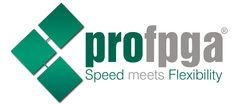proFPGA IP & System Design

Competence Areas
- System Modeling
- System Architechture and FPGA Design
- Software Engineering
- Design processes and methodologies
- Storage Protocols (Host- and Device-Side)
- PCI Express
- High-Speed Analog I/O
Further information and related links
- Price on request:
- More information:
Design Service
In close collaboration with our partner Missing Link Electronics GmbH , PRO DESIGN offers IP and System Design and System integration. MLE was founded in 2010 by a group of business and technology veterans in the semiconductor and embedded systems domain and, since then, has established a reputation for delivering robust solutions in a timely manner. MLE has a sales and R&D office located in Germany and is headquartered in Silicon Valley.
The convergence of Software and Programmable Logic is driven by the advent of powerful multi-core Application Processors integrated with leading edge FPGA fabric. High-Performance Embedded Systems designers, thereby, receive more choices to deliver solutions within demanding cost/power/performance envelopes. The full utilization of those benefits requires new methodologies and deep FPGA expertise. Missing Link Electronics (MLE) has been at the forefront of these developments for many years, and supports you and your projects with expert knowledge and dependable solutions.
System Modeling
- System-level modeling and validation using IEEE-1666 SystemC
- Transaction-level modeling for hardware-software co-design
- Virtual prototyping with Matlab/Simulink .
- Bus-Functional Models (Cadence BFM) for AXI4 On-Chip Interconnect
- Virtual Prototyping based on QEMU and/or Cadence VSP using SystemC
System Architechture Design
- Multi-processor embedded systems design
- Hardware / Software Co-Design
- Hardware acceleration of software algorithms
- Hardware and software design for audio/video/multi-media applications
- Distributed networks such as CAN, LIN, and others
- Heterogeneous compute architecures
- Streaming media architecture
- Single- and multi-channel Direct Memory Access (DMA)
- Machine vision systems with open Computer Vision (opencv.org)
- Machine learning using reduced precision neural networks
FPGA Design
- Altera, Lattice, MicroSemi and Xilinx tool chain
- High-Level Synthesis with design entry using C/C++/SystemC
- Xilinx SDSoC software acceleration methodology
- Register-Transfer Level (RTL) design in
- IEEE-1076 VHDL
- IEEE-1364 Verilog HDL
- RTL verification and testbench design RTL simulation using state-of-the-art tools such as Xilinx ISim or ModelSim/Questa
- Clock Domain Crossing (CDC) design & analysis
- Timing Analysis and Timing Closure
- AXI4 On-Chip Interconnect for regular, lite and streaming
- Multi-gigabit transceiver parameterization & integration
- Multi-chip connectivity via AURORA protocol
- Rapid hardware prototyping
Software Engineering
- Complex software architecture and algorithm design
- Programming in C, C++, Java under UNIX and Windows operating systems
- Embedded Linux software development
- Software development with automotive OSEK OS
- Software development and debugging for embedded micro-processors such as
- Graphical User Interface (GUI) design with Python TK, Tcl/Tk
- Multi-threaded applications and GUI design using QT
Design processes and methodologies
- Automatic Build Environments, like Jenkins or buildbot, for consistent concurrent development of hardware (FPGA) and software (device driversand applications)
- Diligent use of version control, release management and issue tracking
- Design for Safety-Integrity Levels
- System-level security
PCI Express
- PCIe standards Gen1, Gen2, Gen3, Gen4
- Hardware and software development for End-point and Root-Complex, NTB
- Linux device driver development
High-speed analog I/O
- JESD204B connectivity IP
- Subclass 0
- Subclass 1
- Parallel or serial interfaces to analog-to-digital converters (ADC) and digital-to-analog converters (DAC)
- Delta-Sigma converters
Multi-media protocols
- Serial Digital Interface (SDI)
- LVDS-based Custom Camera Interfaces with Clock Recovery
- High-Definition Multimedia Interface (HDMI) wired and wireless
- Audio-Video Broadcast (AVB)
